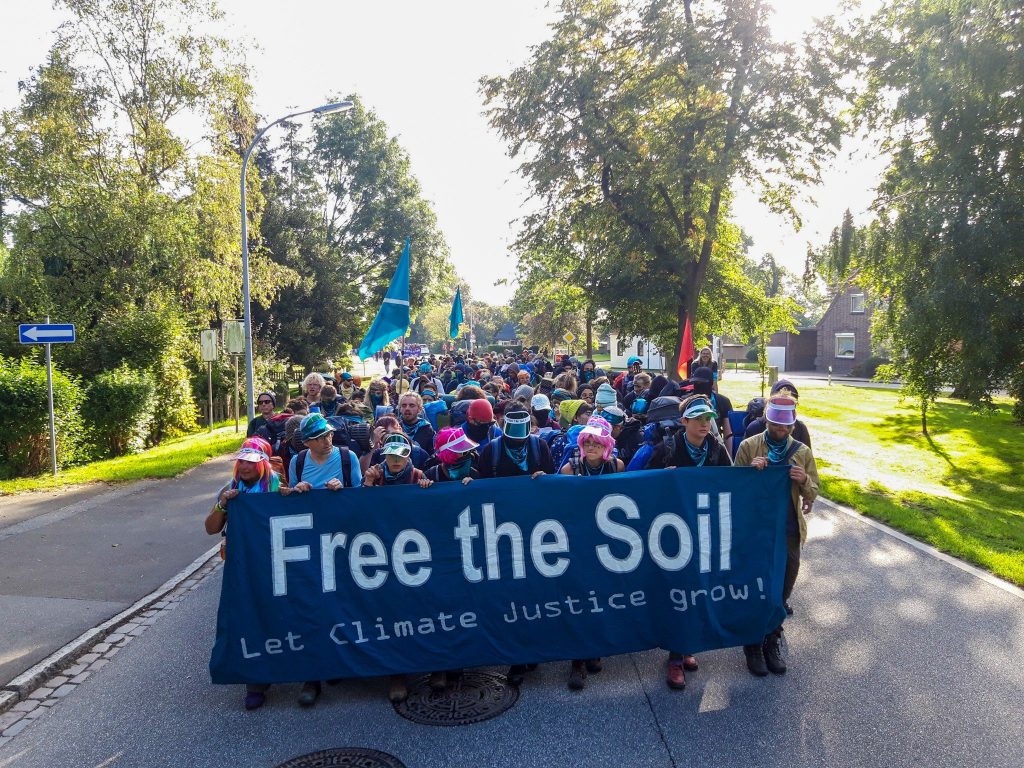
Hoping from one train to another, trying to reach San Margeretta (a small German village in Schleswig-Holstein, close to the Danish border) I am approached by a man in his 60’s, asking if was I on my way to the climate camp. When I told him that I was, he made himself comfortable beside me. He was on his way back from Hamburg, where a group of activists gather on the last Sunday of every month to show their solidarity with their imprisoned comrades, and to maintain pressure for their release. Before long my new train companion was launching starry eyed into stories of actions and campaigns of the previous decades. Our train nears the station but we have another bus, ferry and car ride before we reach a small field, wedged in between a road and cow pasturage, surrounded on all sides by wind turbines, with the North Sea out of sight but in the air.
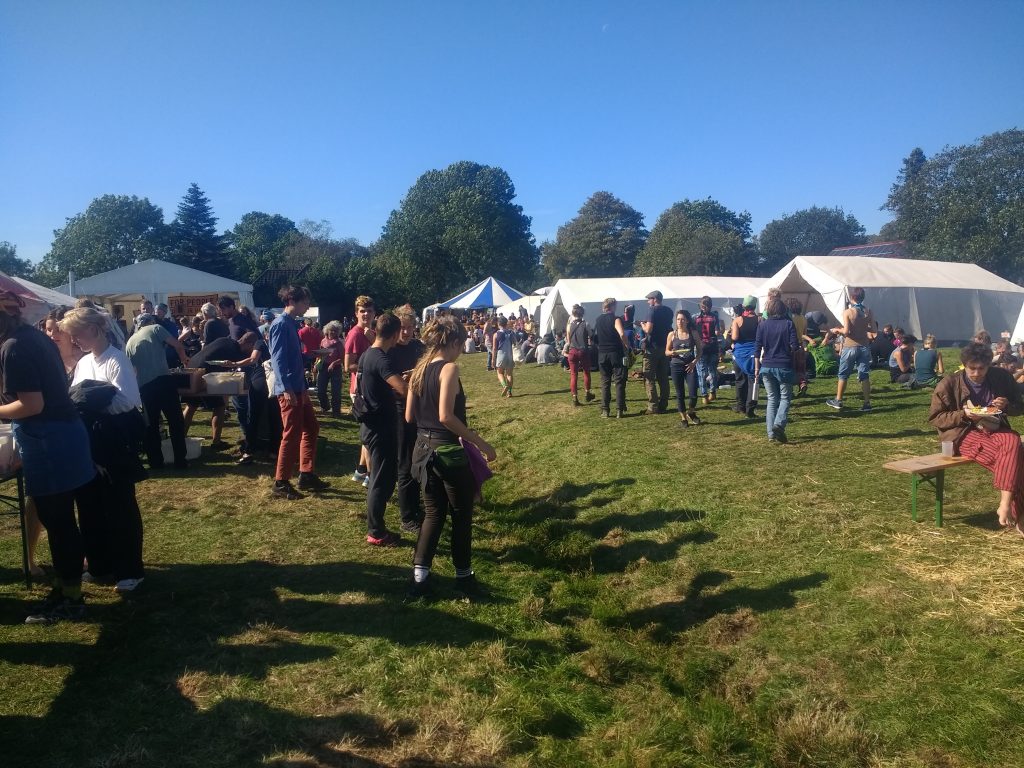
In this field we will find the climate camp Free the Soil. There is already a brief explanation of the idea of climate camps in the piece on Leipziger Land, so here we can start with a few differences that I perceived between this camp and that. The first thing is that Free the Soil was a pan European climate camp. Although Leipziger Land concerned itself with continental and global struggles, it was organised by Germans and 90% of the people there were German. Free the Soil was organised by a chain of groups from Copenhagen down to Antwerp, and so brought together Germans, French, Danish, Belgians, and Dutch in coalition. The main working language during the camp was English, with translations usually offered in French and German.
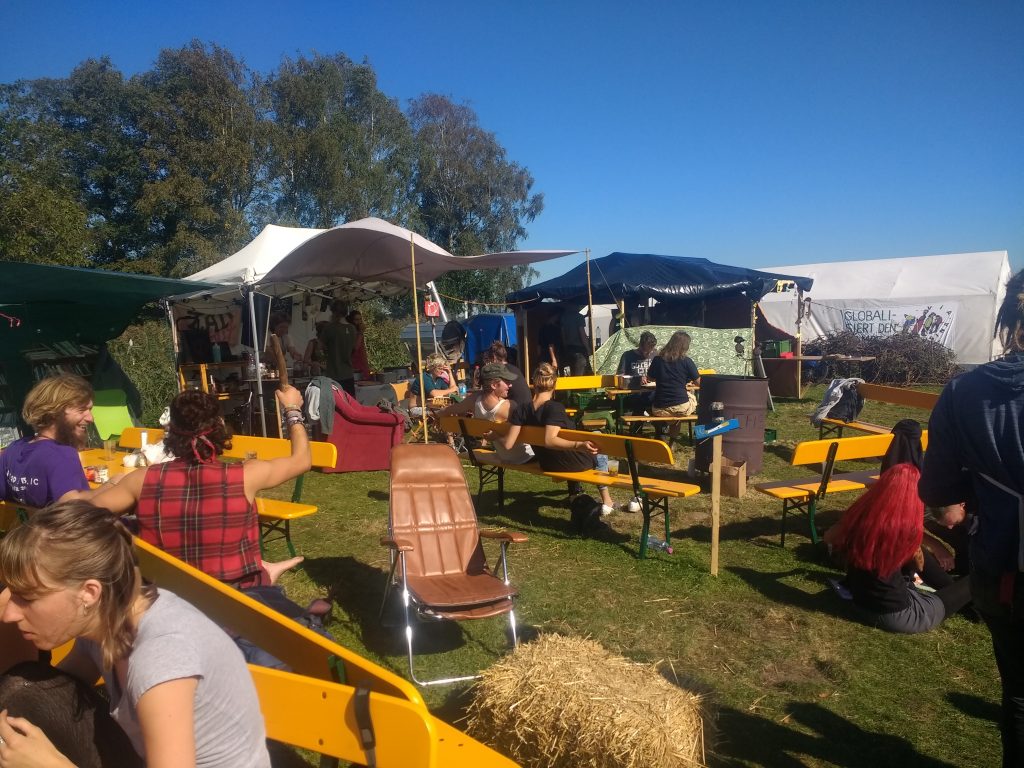
Another difference I noticed was that, whereas Leipziger Land was more focussed on the camp elements of the event (the workshops, talks, activist networking), Free the Soil was more focussed on the direct action that would take place at the end of the camp. Part of this perception comes down to the fact that I missed the first couple of workshop days at the camp, emerging too late from the Hambacher Wald, but part of it was also down to actual differences in organisation. While there was a demonstration at the end of Leipziger Land, it was more of a standard legal street demonstration. Free the Soil had more confrontational action in mind; stopping the production at a near-by chemical fertilizer factory. This factory is run by Yara, the second biggest producer of chemical fertilizer in the world.
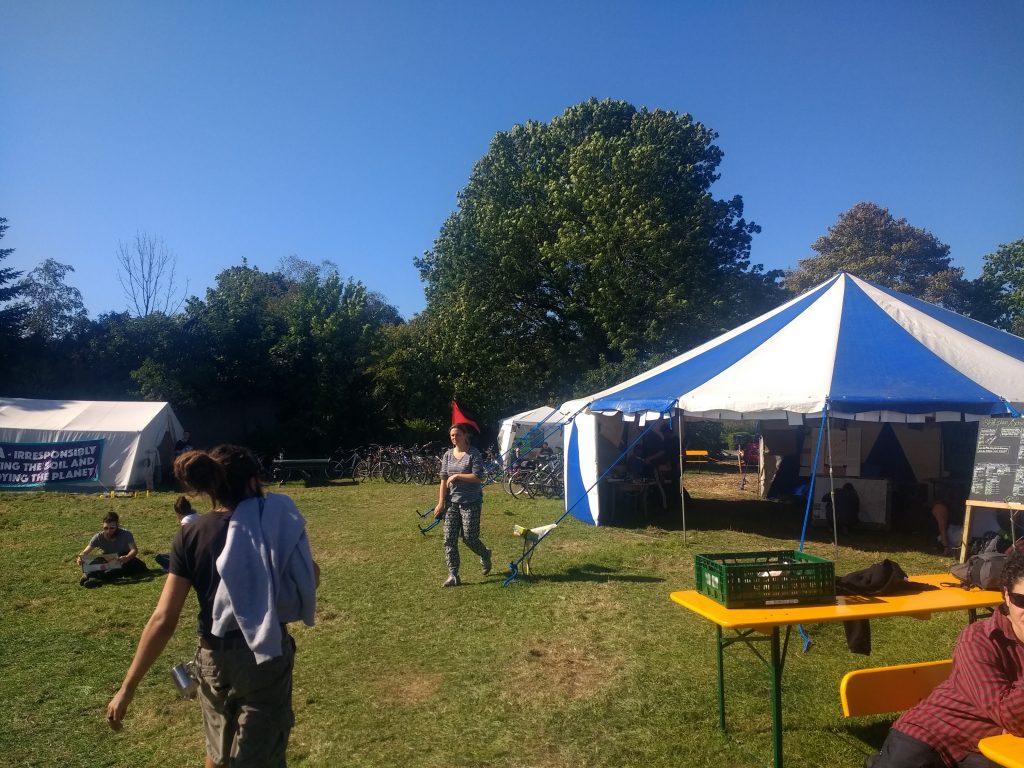
The use of chemical fertilizers has wide ranging, destructive, impacts on the earths ecosystems. ‘Fertilizer’ is any material put in the ground to make it more fertile. Natural fertilizer is decomposing organic matter (so shit, dead plant material, etc.) This type of fertilizer is a useful way of feeding plants, and part of the natural cycle of life. However, because of new modern farming techniques, these natural methods were no longer sufficient. When you turn the whole countryside into a wasteland, there is suddenly not much organic matter to use as compost. When you drain the soil of life (the nitrogen fixing bacteria, for example) you need to replace it with something. So instead of the bacteria producing nitrogen that could feed the plants, you produce nitrogen in a factory. This comes at the cost of huge energy expenditure, as well as meaning you acidify the soil, deplete its natural resources, and pollute the air and water. But hey, at least the depletion and commodification of a naturally occurring compound means the growth of the economy.
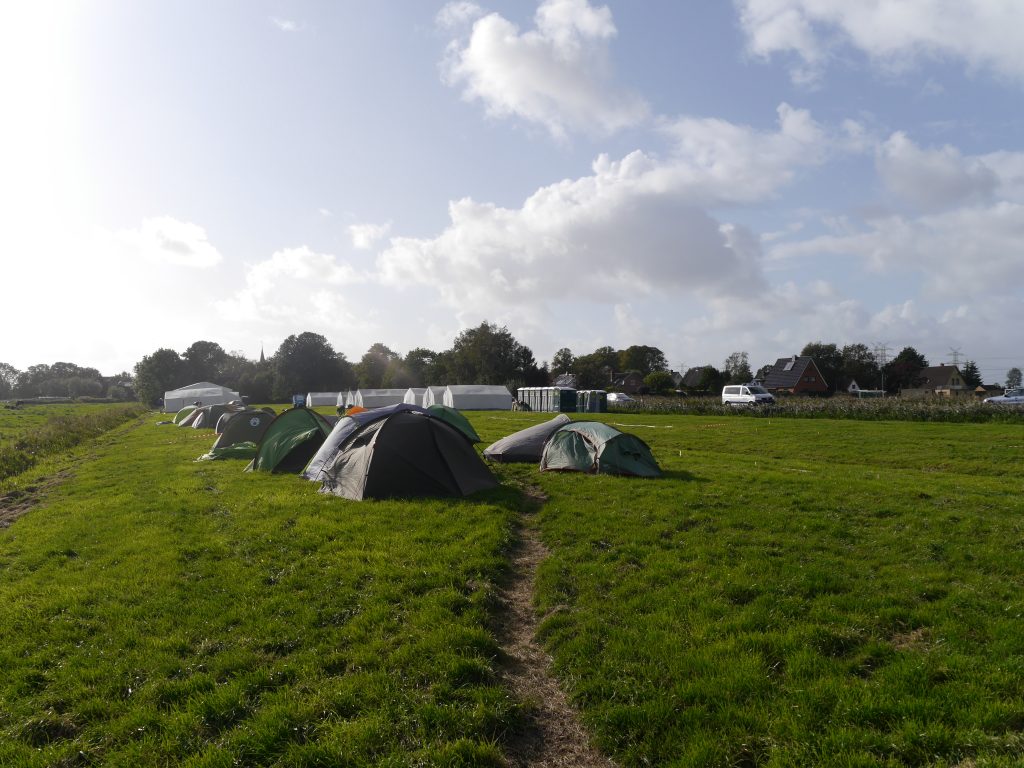
When I asked my train companion if he was at Leipziger Land he told me that he wasn’t, that he worked for the post service and didn’t have enough holiday days to go to all climate camps. He decided to go to this camp because he thought that Free the Soil was more in line with his vision of political action. He wouldn’t go into too much detail, but he told me their was two types of non-violent action; non-violent action that came from a place of fear, and non-violent action that wasn’t afraid of confrontation. After reading the mission statements of the two camps, my train companion thought that this distinguished them, and decided to come here.
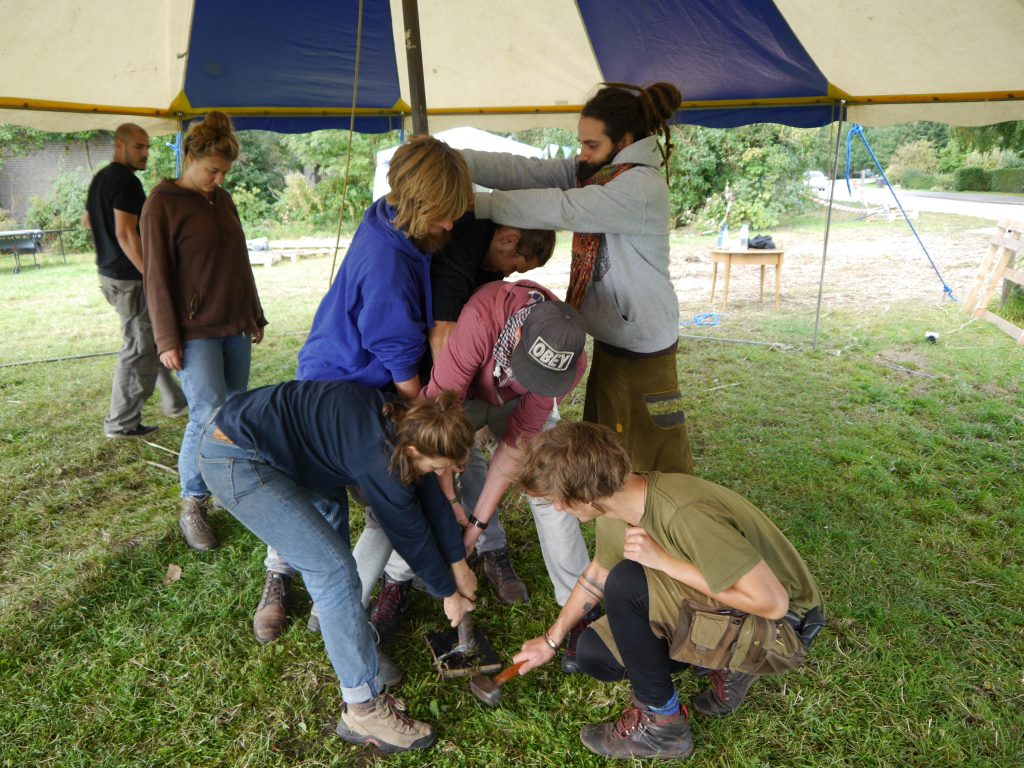
As I said, I missed the few days of workshops and I arrived at the camp the day before the action. By this point, the camp was mainly training and preparation. After being woken up by a disgruntled cow in a neighbouring field I went to have some breakfast and take part in the days first activity, where there was the choice between ‘affinity group training’ and ‘affinity group dating’. An ‘affinity group’ is a group of between 4-8 people who would all take special care of each other during the action. The ‘affinity group dating’ was for people who didn’t yet have an affinity group and so I joined this activity to find one. After an hour of listening to the concept of affinity groups and a few games to get to know each other, we began starting to separate ourselves, mainly according to where we fall in line on the spectrum of low-risk to high-risk activities. As affinity groups should stick together during actions, it naturally makes sense to split according to how far we would be willing to go during these actions, people prepared for more high risk activities grouping with others who were so inclined. After a brief conversation I joined a high risk affinity group and began to get to know my three new comrades.
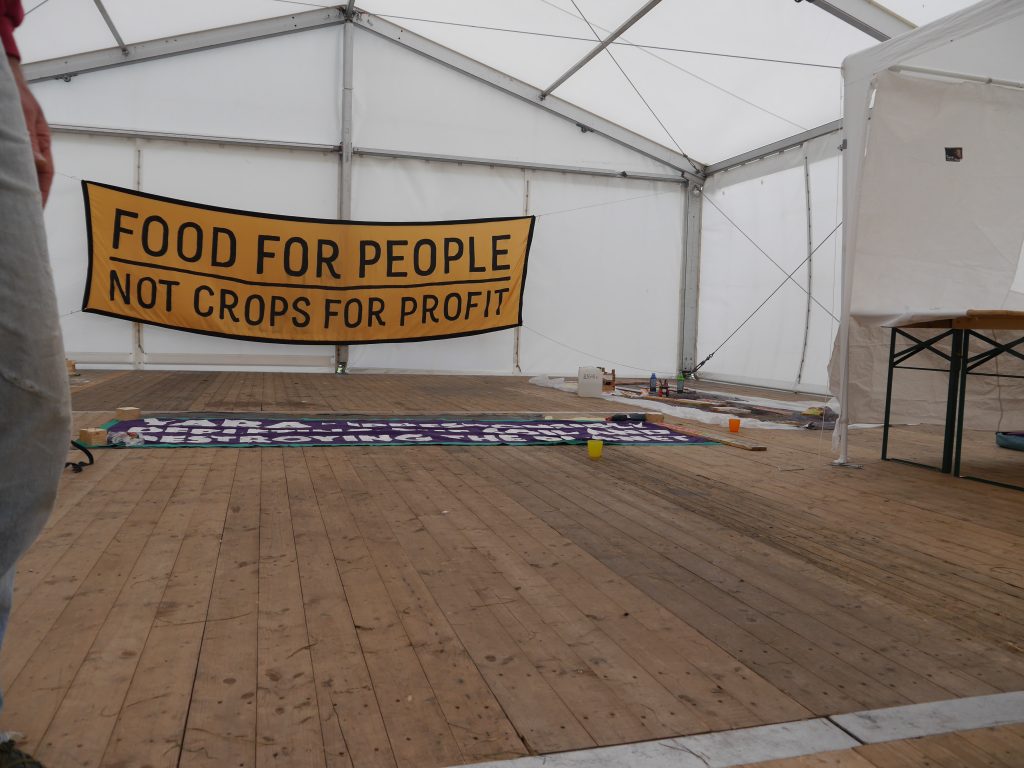
Next in line was to join a ‘finger’. At this stage we can quickly run through the organisational structure of the action against Yara. If we think of the overarching group, everyone involved, as the ‘action group’, the first division of the action group was into fingers. In this action there was two action fingers and one support finger. The action fingers were the ‘purple finger’ and ‘turquoise finger’, the support finger was the ‘camp finger’. The action groups would obviously take part in the action and the camp group would support the action groups with food, material, etc. The fingers would co-ordinate together but be able to act independently from each other. I was told that in some actions different fingers have different levels of risk, but at Free the Soil we were told that the two fingers would probably have the same level of risk. However, we decided on the purple finger because a member of the group heard that there was the possibility of special actions, and we could meet inside the purple finger tent later in the afternoon to learn more.

Upon entering the purple finger tent which, unlike most other tents, was closed at this time, we were asked to leave mobile phones outside. Inside the tent there were two group, one speaking French, one English and, although we arrived too late to join the English speaking group, I didn’t need to understand French to understand what the special action was. A lock-in is the tactic of locking yourself to something to make it more difficult for the police to remove you from an area. The purple finger were offering materials for two methods. The first was a neck lock, in which a group of three people would sit in a circle with their backs to each other and lock themselves together by the neck with bike locks. The next was an ‘armlock’ in which two people (or a chain of more than two people) who put there hands in a chain bracelet and then a plastic pipe with a metal rod in the middle. One could attached the chain bracelet to the rod very easily from the inside but it was not possible from the outside. After this demonstration we were told to return later that evening if we were interested in this special action and take the materials. After a short meeting with the affinity group it was decided that the other members of the group would take the materials for this action, but one of us should not be chained, so as to be in a better position to help the others who were chained. I was happy enough to play this supporting role for my soon to be chained comrades.
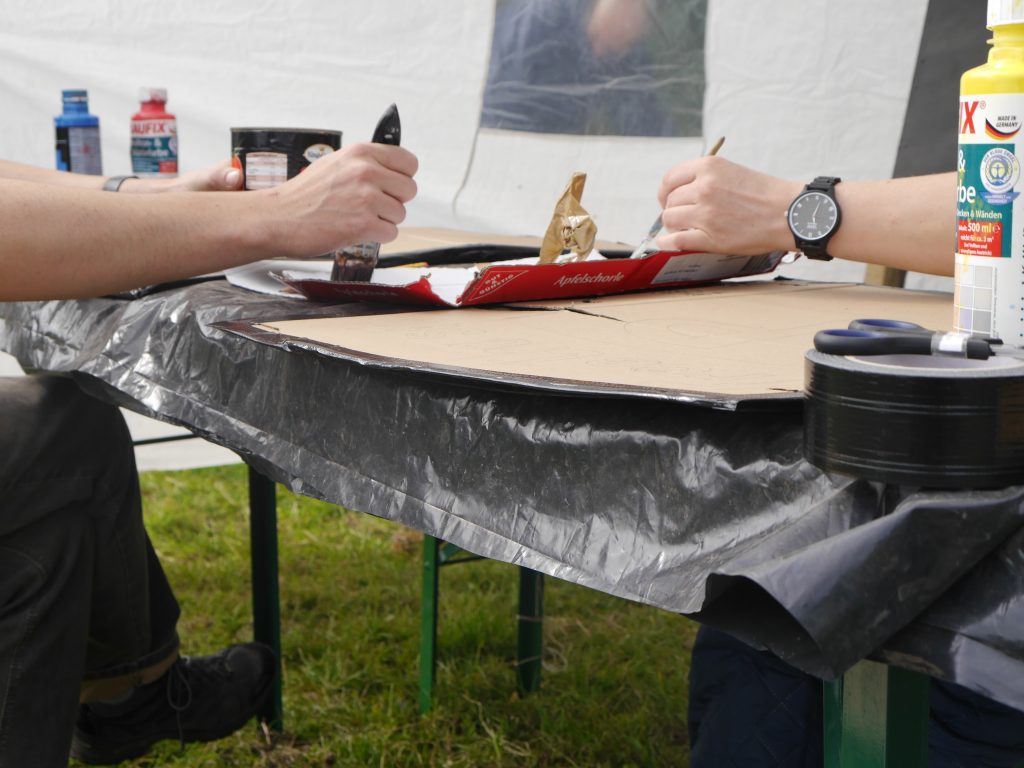
Next on the list on this action packed day was finger training. After a quick run-down in the main tent about the meaning of certain hand signals and about the inclusive values of the finger, we went to the field opposite to train how we would move as a unit. The finger was composed of rows of 6, with the groups at the front and the back steering the movements and actions of the finger. The finger would be moved by means of hand signals and call outs, and aside from the basic left-right movements, there was a number of special action that the finger could undertake when faced with police blockades. There was the ‘split’ action, signalled with the index and little finger held out, and meant that the group would split down the middle, with one going left, the other going right. Another hand sign meant ‘stick together’, signalled by a fist. Another meant ‘split up’, signalled by an open palm – causing the finger to form a horizontal line. This was the final preparation of the day, and after a bit of food, and music by the fire, the camp settled down to sleep, excited for what the following day had in store.

After waking up soon after sunrise on a bright warm September day, we had breakfast, found our way to our affinity groups, and formed the finger formation. My group decided not to be in the first few rows because of their special task so we were about one third down the finger. Soon enough we were on the road, marching to the sound of the samba and chants of ‘No more gas/ No more oil/ shut down Yara/ free the soil’ or ‘Aah anti anti-capitalistaaah.. ahh anti…’. The purple and turquoise fingers started out together but early on split up and proceeding down different routes to the Yara facility. The country road was a strange mix of beautiful countryside (chestnuts bearing their autumnal gifts, willows bending down to drink from the passing canal, thatched roofed houses with blankets of moss) and heavy industry. Aside from the chemical fertilizer plant, there is also many wind turbines, solar panels, as well as rely points for the natural gas harvested from the North Sea. Until recently it was also the site of two nuclear power stations, and so this was certainly not the first political action which had taken place here.
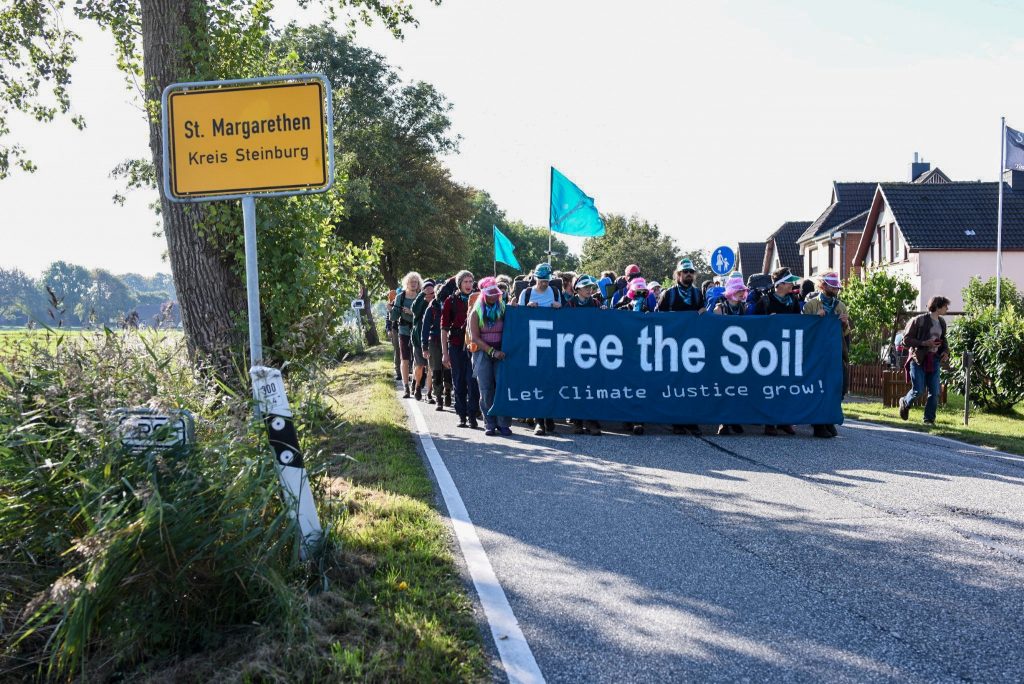
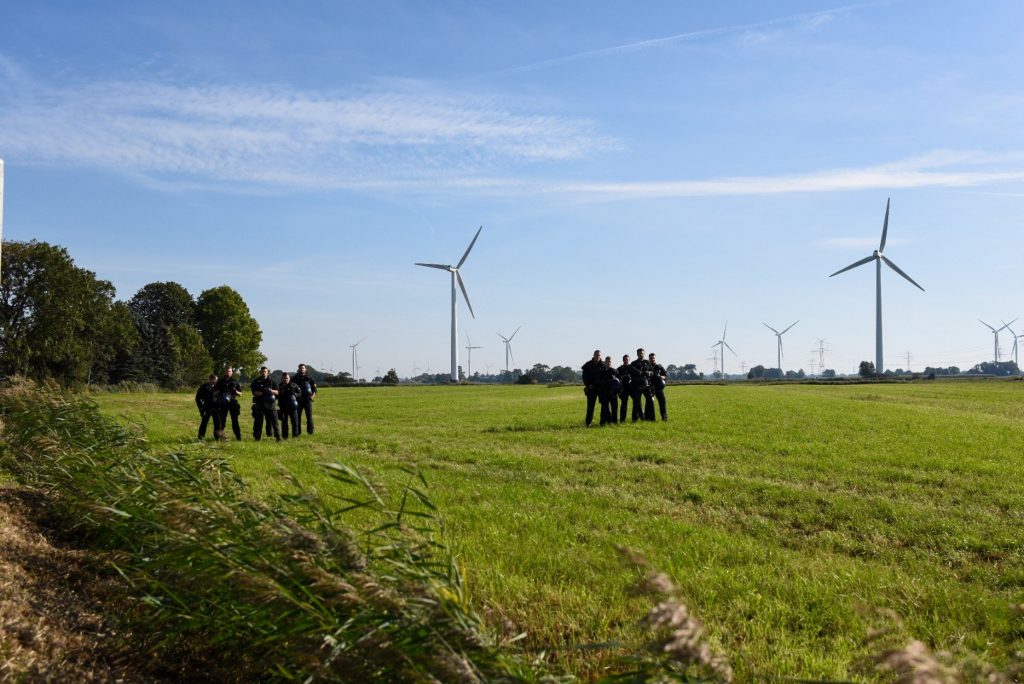
After
about an hour of marching, Yara’s production facility was in sight,
as was the turquoise
finger who proceeded in formation about 400 meters ahead of us on the
road. As
we were reaching the police blockade, most people were eagerly
awaiting a hand signal from the top of the finger. At
this point it was still
unclear to most people what exactly the plan of action was. Although
the action was run on anarchist principles of decentralisation, there
was obviously a group who had scouted the area during the previous
few weeks and were somehow directing things.
The
exact nature of these plans were kept a secret, even from the people
involved. A hand went up and fell right and so we turned off the main
road into one of the entrances, blockaded
by of a few dozen police and
a handful of police vans on a wide road. At this point excitement was
rising and eyes started to dart around looking for potential holes in
the police line. After about a minute lined up face to face with the
police, the call came that we were to sit down and take up space. We
would be blockading the entrance. Two
tripods went up with a person on top, hindering the police from
clearing anyone without injury, and the rest of us sat down and began
the blockade. There was
apparently two main entrances of the facility, and blockading both
was going to be the tactic for shutting down production.
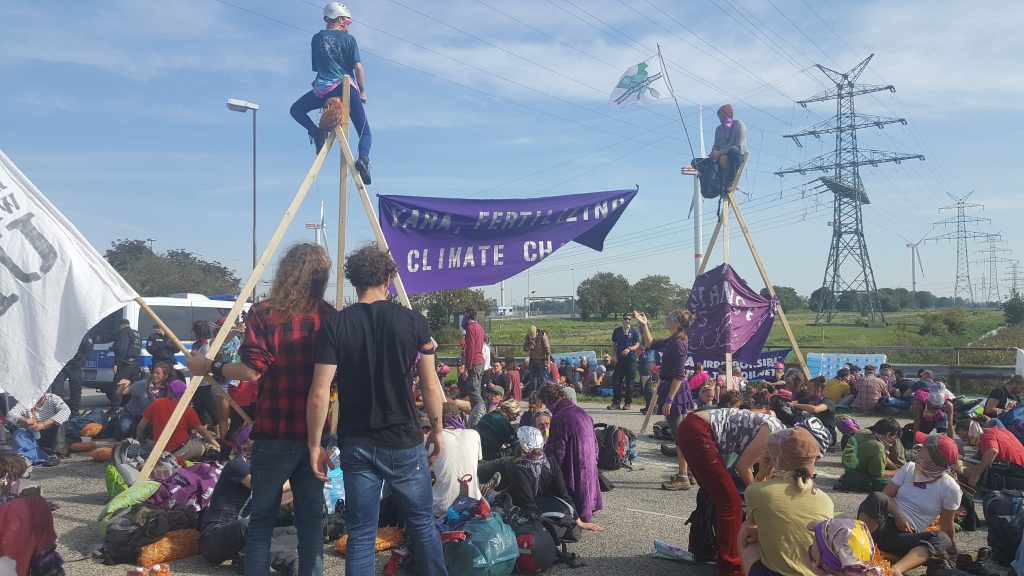
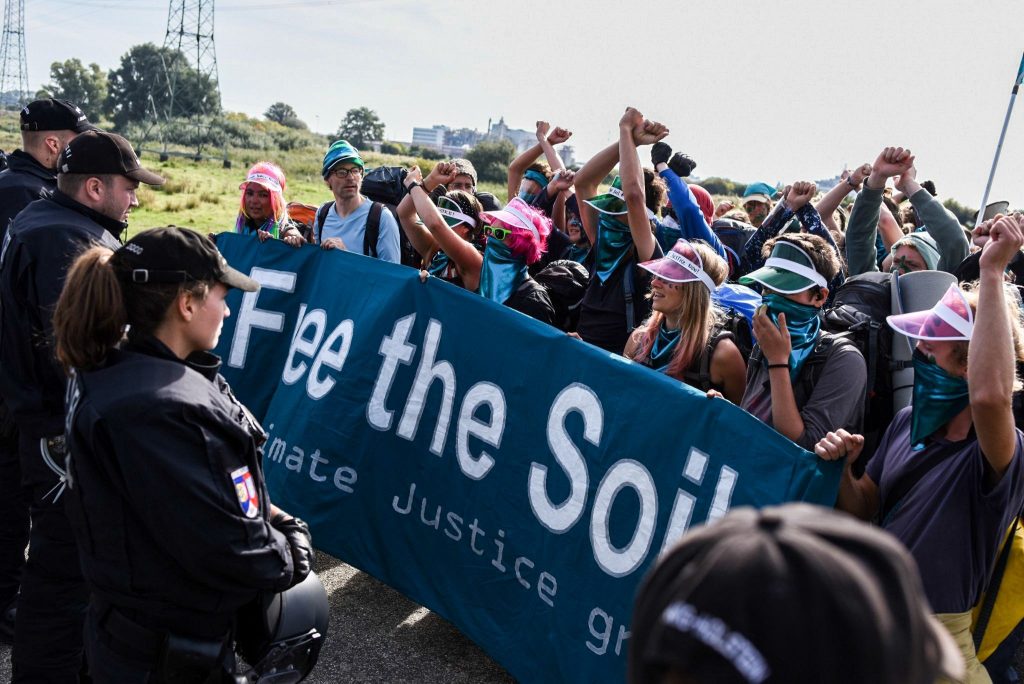
The blockade began at about noon and was to last until 3 o’clock the following day, and so people began to settle into what would be a long day, night and morning. The sun was shining, and most people began to tuck into the food that had been handed out that morning. People were playing cards, chatting, or napping. The samba bands sometimes played, and there were a few spokes councils, in which each affinity group would send some to discuss the organisation of the blockage. A tent was set up at the back of the blockade with tea, water, and someone from the legal team. After some time I found out that the blockade was declared legal until 6 in the evening, but I’m not sure if that was registered beforehand or negotiated on site. Because it was legal we had the right to walk around the perimeter of the site and visit the other finger. Upon visiting the other finger I was not surprised to see that the ‘more German’ finger had a van with a large sound system, music and people dancing (German political actions are often undistinguishable from street parties).
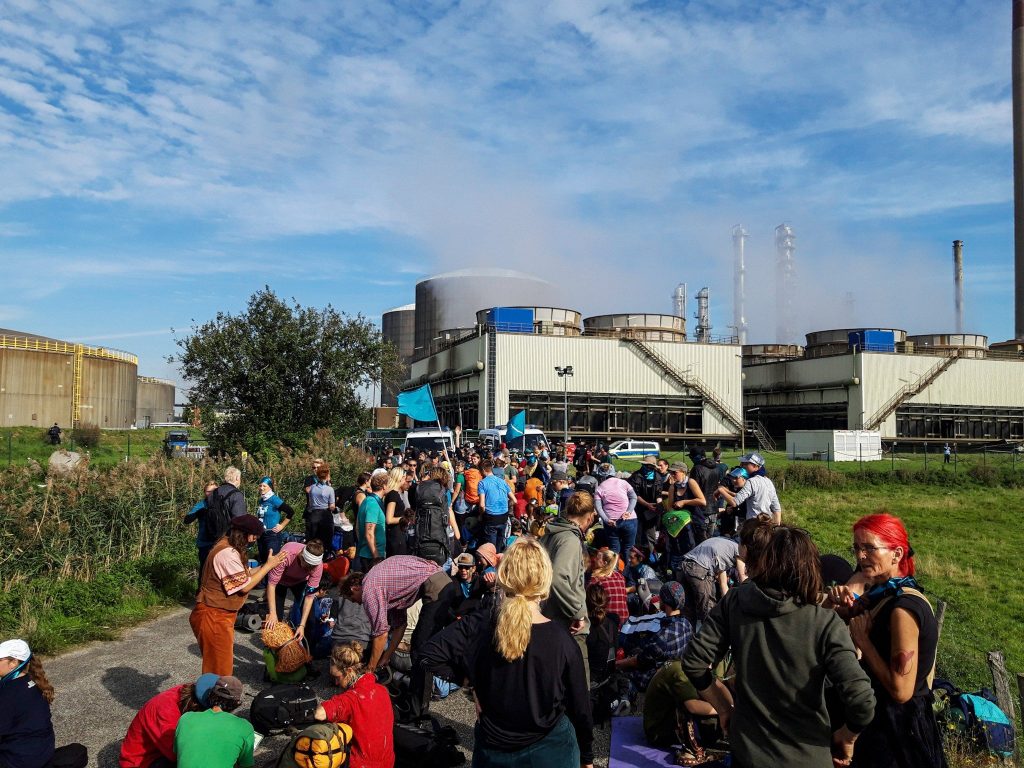
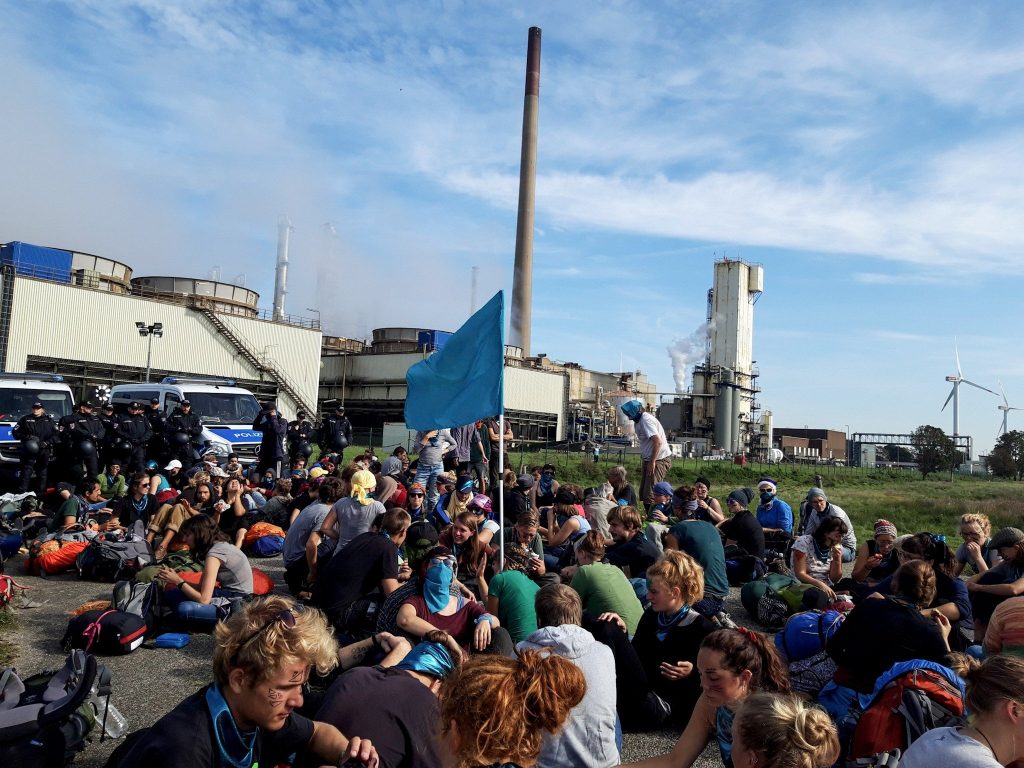
After it became clear that there was not going to be any more actions from the finger, a bit of grumbling began to manifest, a few peoples questioning the efficacy of the blockade. Rumours began to go around some people of the turquoise finger were planning to break into the factory. Suddenly, there was much police scuffle, and we saw a person high up on the electric tower, earning some cheers and samba sounds from the purple finger below, along with the attention of the police for the few hours it took to get them down. There was then word that about 20 people (it later turned out to be 12) had formed a new finger and was blockading a third entrance, in which staff and police could still enter the facility. They managed to blockage this third entrance for a short time but the low numbers meant that police could move them with relative ease. At about 5 food arrived, prepared by the camp finger. After enjoying our vegan burgers, we prepared ourselves for possible confrontation with the police as the time of the legal protest was coming to an end. But it never came. A short time later it was announced that the blockade had been declared legal until 3 o’clock, the rest of the time we had planned to blockade. The police and factory officials obviously found our actions tolerable enough. The sky turned from blue, to white, to grey. As the first flecks of rain were felt people began to erect makeshift shelter with tarps and string and sticks.
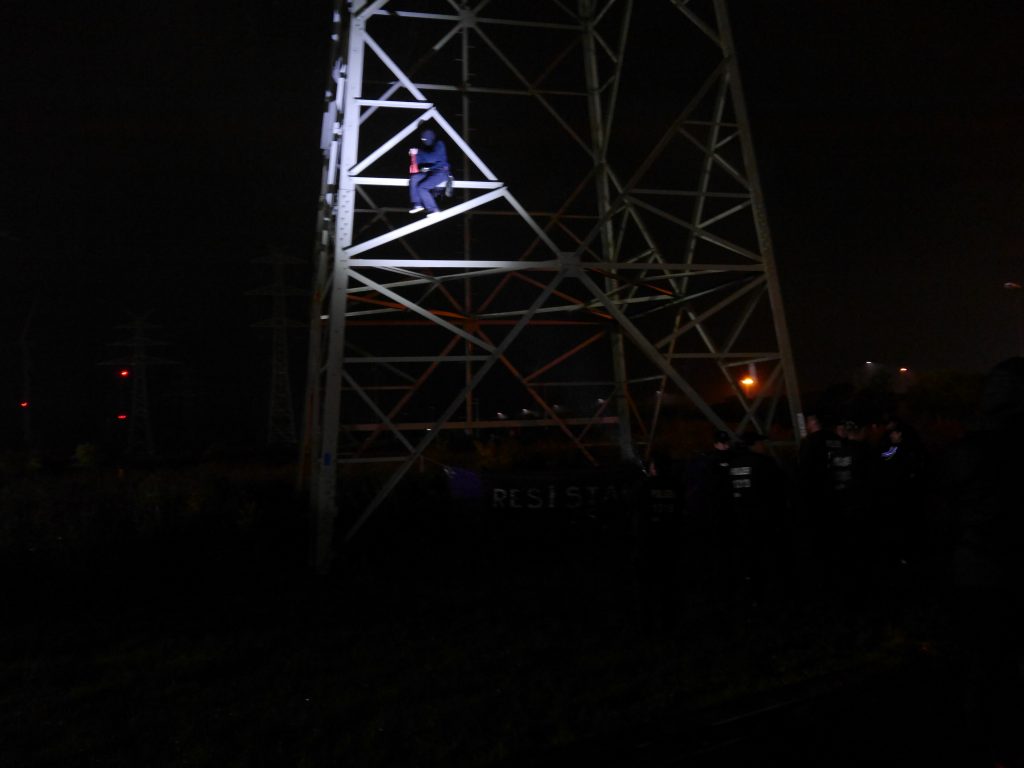
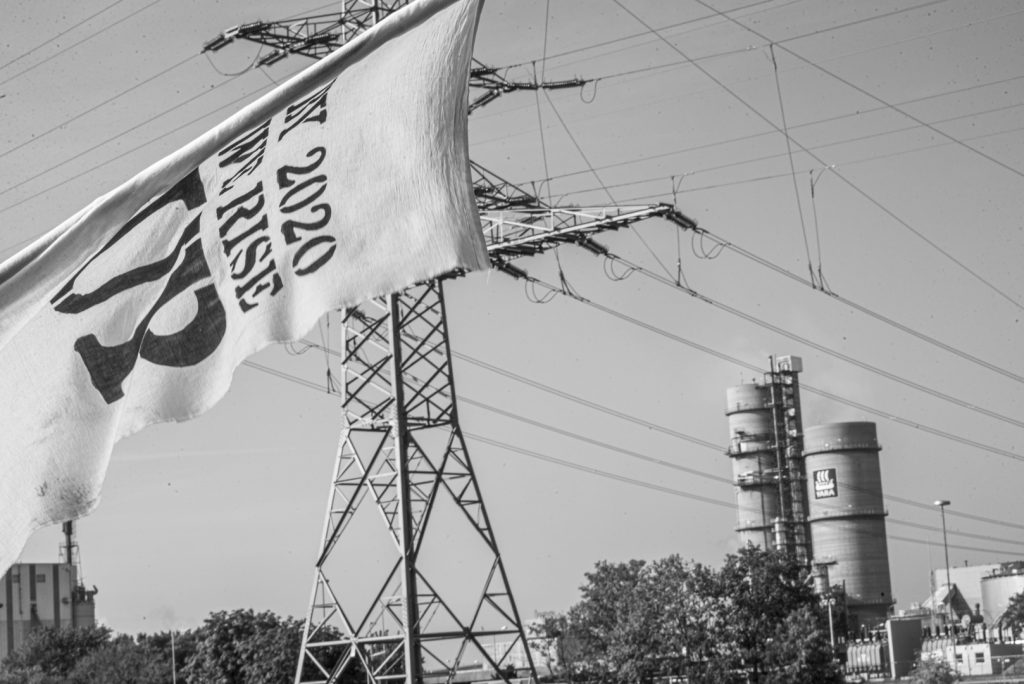
As night arrived, some began to settle down under the low tarps, a damp mass of sleeping bags and blow up mattresses, while others made plans with hushed voices, under the dim light of head torches, focused on a map of the Yara facility. There was one group who planned on re-forming the yellow finger and re-blocking the third entrance. My affinity group was at the centre of another group who intended on breaking into the facility. The plan was to snip through the fence and attempt to shut down the production somehow, as was the stated goal of Free the Soil. It was said that merely breaking in, and being on the loose would be enough to halt production because of health and safety protocols. Enough people decided that this action was should happen, so a few teams went off to scout out potential access points in the fence. In this interval, to my shame, I went to have a nap, which turned into a sleep. The next thing I knew I was waking up on a misty morning, hearing reports that 12 people broke into the facility, 7 being arrested immediately, and 5 still chained to the roof of the facility.
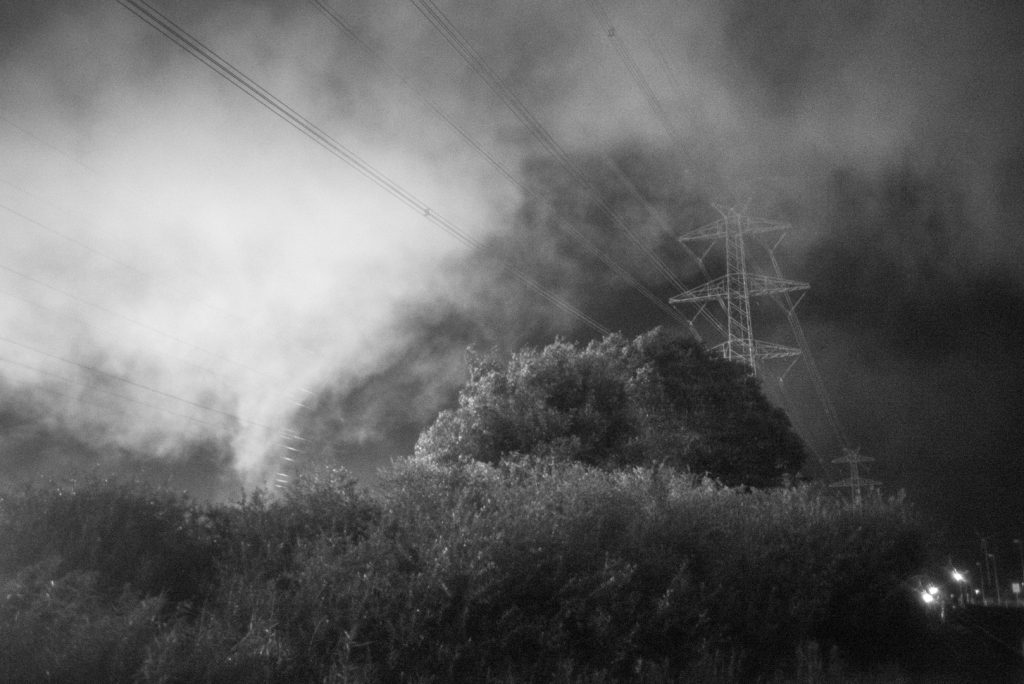
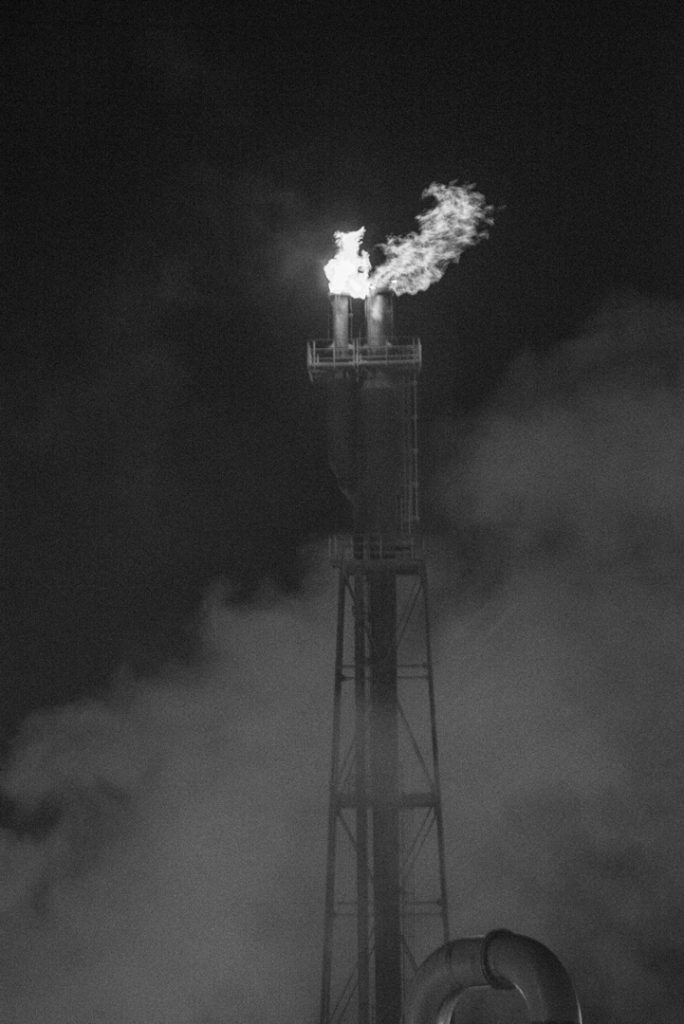
Disappointed at having missed the action, I was consoled by seeing new plans taking shape. Many people weren’t happy at how comfortably the police and Yara were dealing with the action and a lot of energy started to gather around the idea of a new yellow finger. It was unclear as to what this entrance was being used for (at least staff and police, but perhaps also trucks). Unclear also was how heavily fortified it was, but yesterdays eviction proved that police didn’t want us to be there, and that was enough for most people. A spokes council was formed to prepare for the formation of a new yellow finger and it seemed about half of the purple finger, 70/80 people (included the Samba band), were going to join, with the rest remaining at the legal blockade. We sent a few people ahead to inform the turquoise finger of the plan, in case some of them wanted to join as we passed their blockade. We then made the finger formation, and set out to the sound of samba, aware that this action would not go down as well with the police as the last. In the distance we could see the last people being taken down from the roof of the factory, earning the last cries of support from the purple finger.
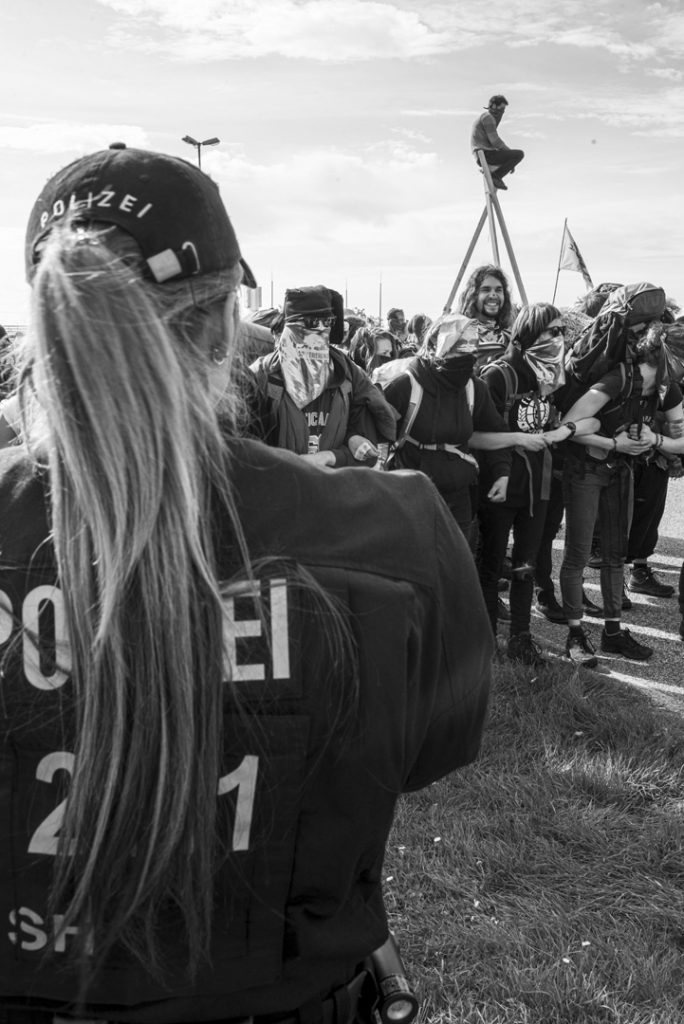
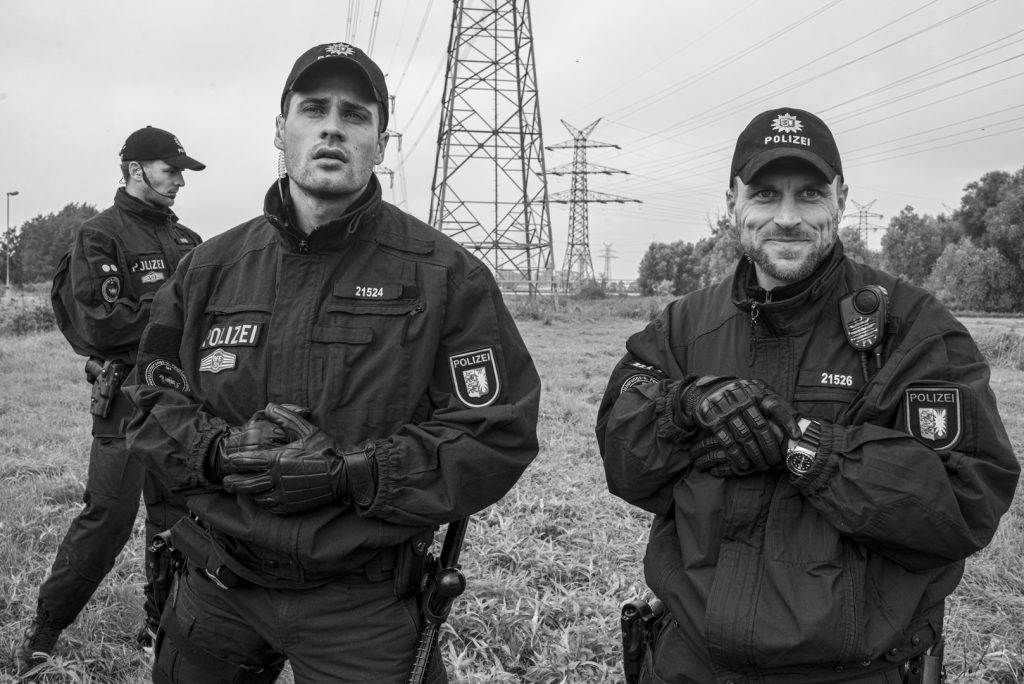
After walking up the street about 200 meters, we could see that the police had set up a blockade just after the entrance blocked by turquoise finger. The street was blocked, but the green spaces on either side of the blockage weren’t. Whereas I, and a few people around me, thought that this situation called for a ‘split’, those at the head of the finger veered right, pushing into the wall of police. This turned into a scrum, the police all piling in behind each other to hold our finger back. But out group was larger, allowing some people to peel off and run toward the third entrance, another 500 meters up the street, while about half of the finger stayed in the scrum with the police. This tactic proved effective, and the police eventually abandoning their position, falling back to create a new line, earning us about 300 extra meters. As the police fell back, the rest of the finger caught up with us, and we spread out along the new police line, standing face to face with the heavily armoured wall.
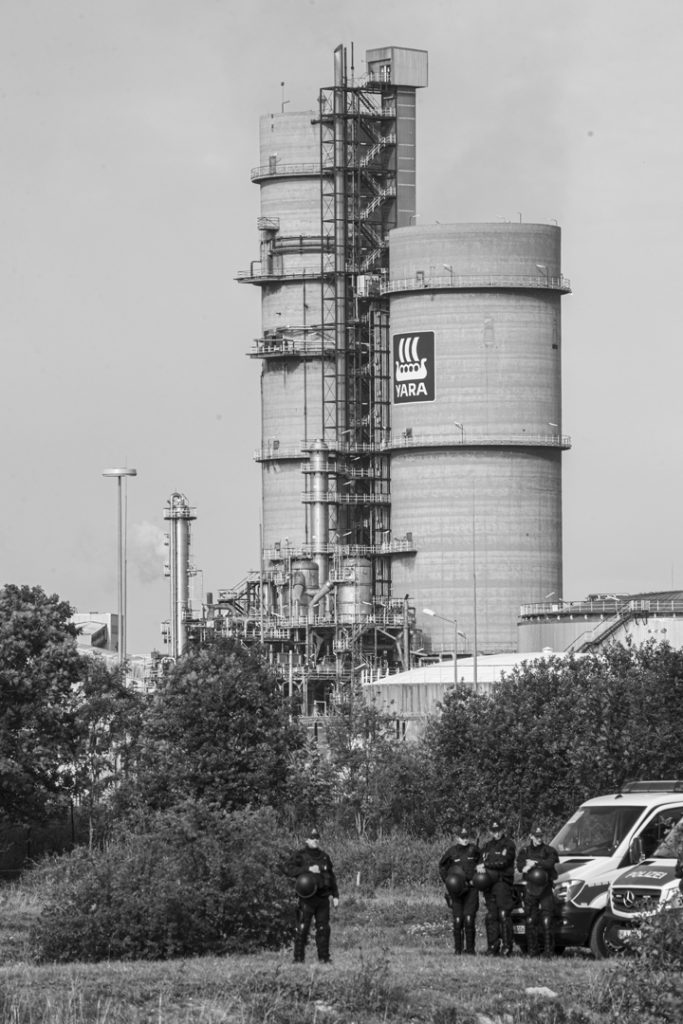
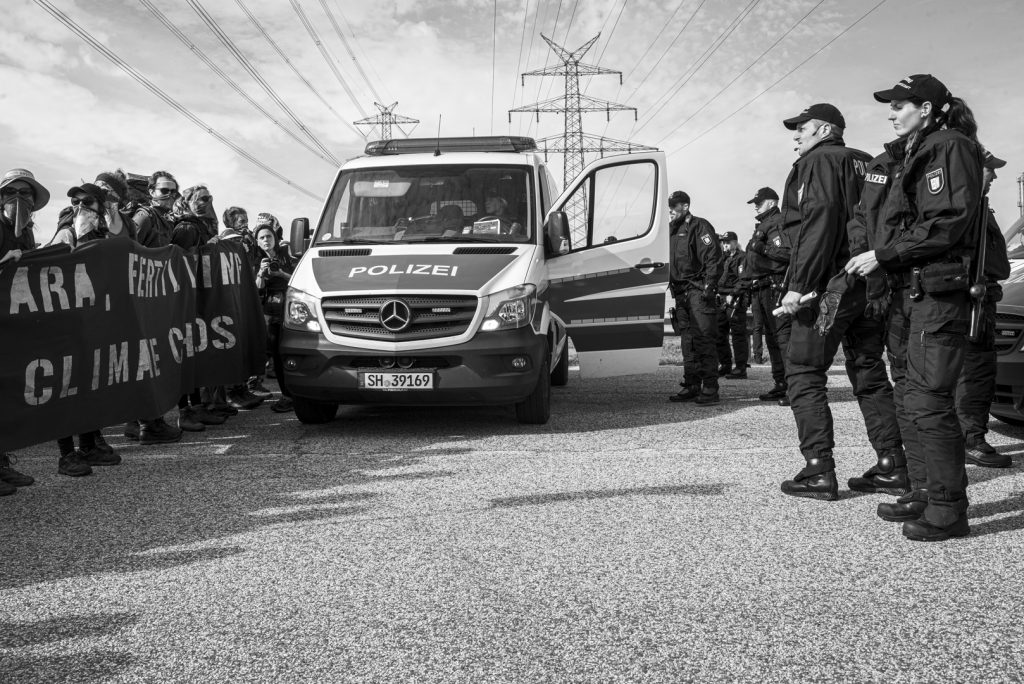
This time however, no longer in formation, up against a reinforced wall with no gaps, a break through proved more difficult. A few of us attempted to break through individually, but this provoked police violence, shoves to the ground, kicks to the head. People started to wade through the canal that lead to an unblockaded green space in between the road and the Yara facility. But after a minute or two it was clear that the 20 or so people who did this would meet too much police resistance, and they retreated. As the newly formed yellow finger stood up against this new police line, a line which was been reinforced with even more heavily armoured police at all times, it became clear that this operation would not be successful. We called an emergency spokes council to decide what to do, with some wanting to stay and some wanting to leave, but as police announced through the mega-phone that we were about to be forcefully removed, and started moving in our our position, the spokes council broke up. Very few people were prepared to suffer more police violence.
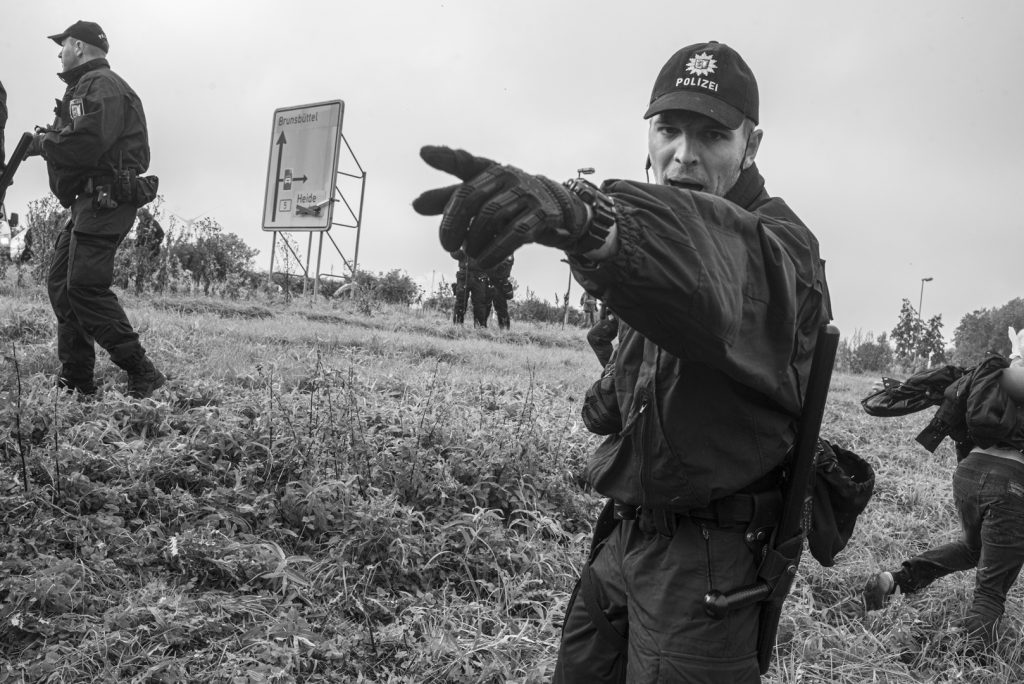

On our way back to the legal blockage, the police were walking behind us every step of the way. After a few steps I lagged a bit behind to talk with them. Behind every uniform is a human being who lives in the same world that we do, experiencing the same collapse of the worlds ecosystem that we are.
‘Do you have any kids?’ I usually started out asking them (in what is maybe a bit of a cheap shot). Sometimes I was answered with blank stares or sarcastic remarks, but sometimes with sincere responses.
‘I don’t’ replied one policeman.
‘Do you every want to?’ I asked.
‘Probably one day.’
‘Well what will you tell them about what’s happening here today? How will you justify protecting those who are destroying the world and their future?’
He paused for a second before saying ‘I don’t know.’
‘Well have you thought about it?’ I asked.
‘I have’ he said, indicating his ethical uncertainty at the situation, before walking off.
Another older police said ‘I am against the destruction of the environment and I am totally with you in your legal blockage, but as soon as you start getting violent then I am no longer with you.’
‘Violent?’ I asked him ‘How were we violent? Your colleague kicking me in the head was violent, we were doing nothing of the sort.’
‘You trying to charge our lines and illegally blockage the streets was violent.’
‘I would say that the real violence is happening here behind our backs, the production of poison and chemical fertilizers, polluting the earth and air. This is the violence that you are protecting. What we were doing was trying to prevent more violence.’
‘I believe in the law’ he said ‘and if people start doing what they want, it will only lead to chaos’
‘The law and ethics are two different things.’ I replied ‘Slavery was legal, the holocaust was legal. Doing what is right does not always mean doing what is legal’.
‘That maybe so, but I have my opinion and you have yours, however, overall I am still on your side.’
‘If that were the case’, I told him, ‘then you would be on this side’ indicating toward the purple finger.
‘Well you have to say that I am at least in between.’ To which I smiled because we were indeed in between the wall of police behind and the retreating purple finger ahead.

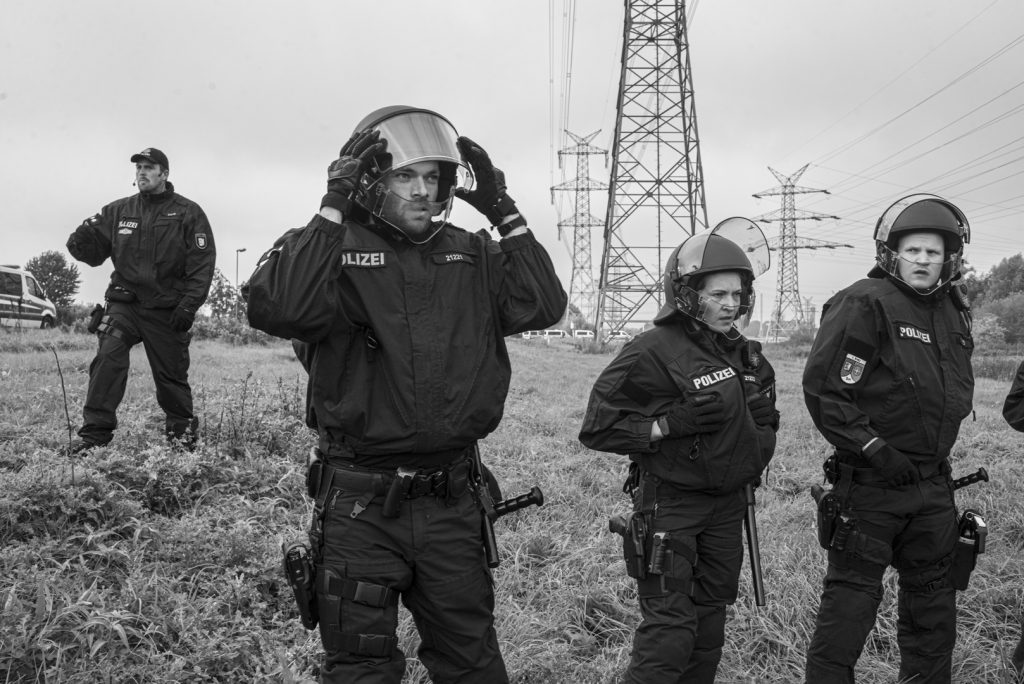
Returning to the purple fingers legal blockage, there was mixed feelings. On the one hand, we were happy to have done something that was not sanctioned by Yara and the police. On the other, the action had failed and it was clear that Yara’s production of amonea wasn’t going to be stopped. There was a final spokes council to see if there was any desire to stay longer than 3 o’clock. There was, but not from enough people to continue blockade, so it was decided that the purple and turquoise finger would head back to the came at 3, as planned. Before long, it was time and we started the long walk back, much looser formation this time. The samba band making music at the back, the techno truck at the front. Arriving back we were cheered on by the camp finger, who created a tunnel with their arms for us to run back in celebration. That evening there was a final plenum in which the total effects of the action were run through; 60 trucks were blockaded, activists made it into the compound, media attention was aroused – but production was not stopped. The evening was capped off with a party in the main tent.
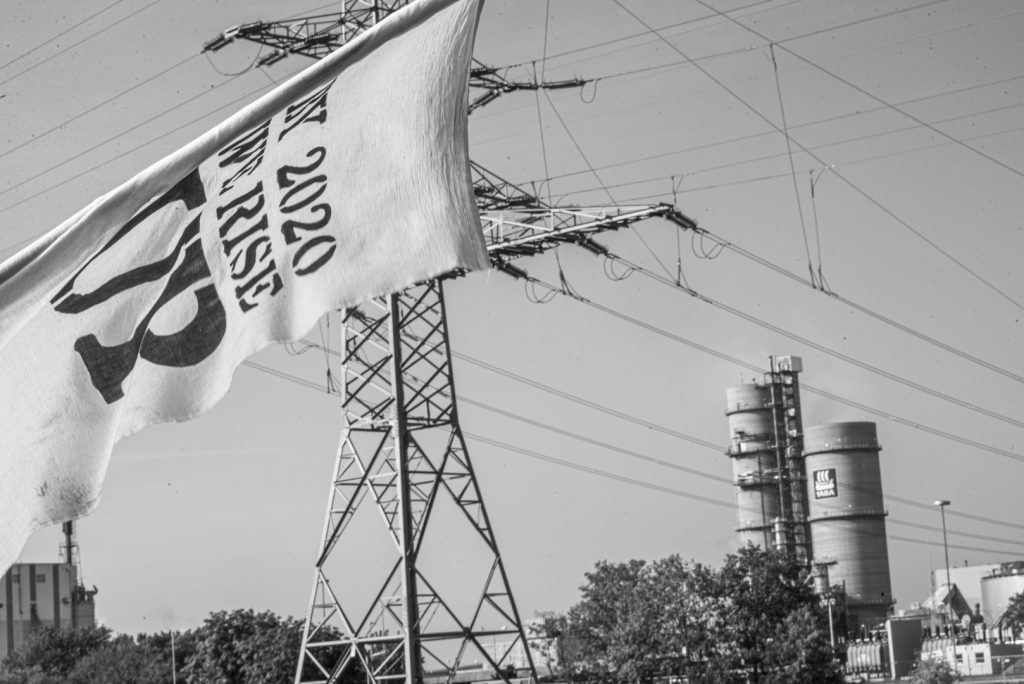
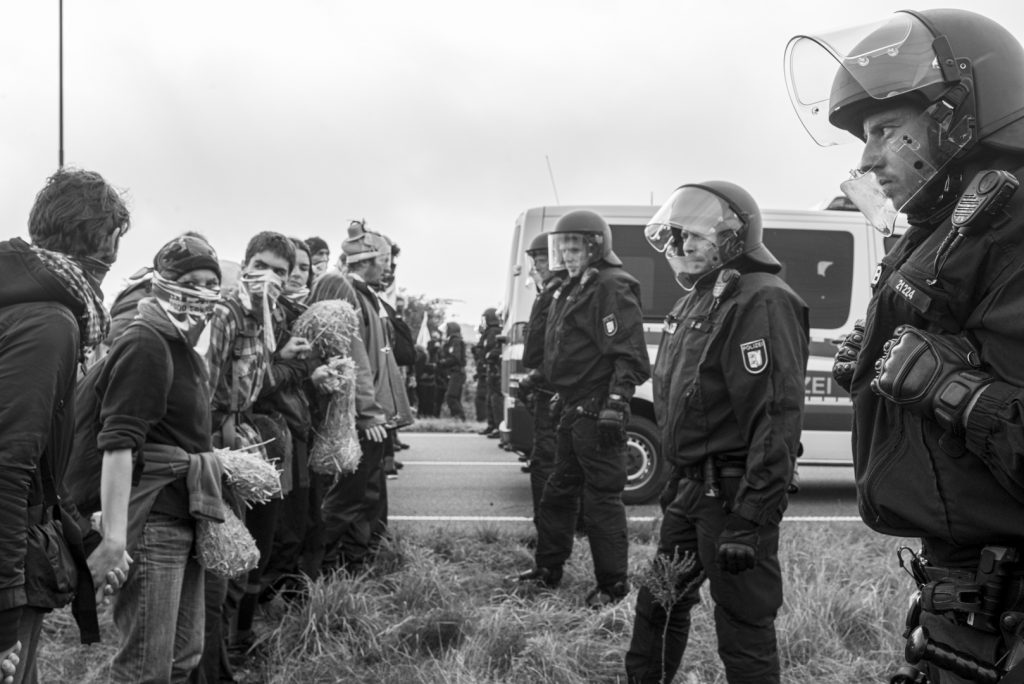
Back at the camp I managed to find my affinity group, released from police custody not long after they had been taken in, who then recounted the events of the night. They set out a few hours after I fell asleep and, with the help two teams creating a diversion, made it into the compound. After cutting the fence, they slipped in but had a police car on their tail. This car managed to apprehend 5 of them but the other five made it onto a near-by rooftop. The police couldn’t find them for the first 2 hours, but were then spotted. To block police access they chained themselves to the ladder they got up on. This allowed them to stay on the roof for the next 8 hours. Eventually the police called in the cherry picker and picked them off the roof. After being apprehended they received no maltreatment and managed to keep their identity secret, although the fingerprints and photos are now on police record. They seemed happy with how events transpired, although naturally exhausted from being 10 hours chained to a ladder on a roof, on a rainy and cold night. I also managed to meet the postman who I first met on the train. He turned out to be one of the original yellow fingers that had blockaded the third entrance on in the first day. He was packing his tent and seemed disappointed. ‘Now is not the time’, he said ‘but in the next few weeks this will be reflected upon to see what went wrong.’
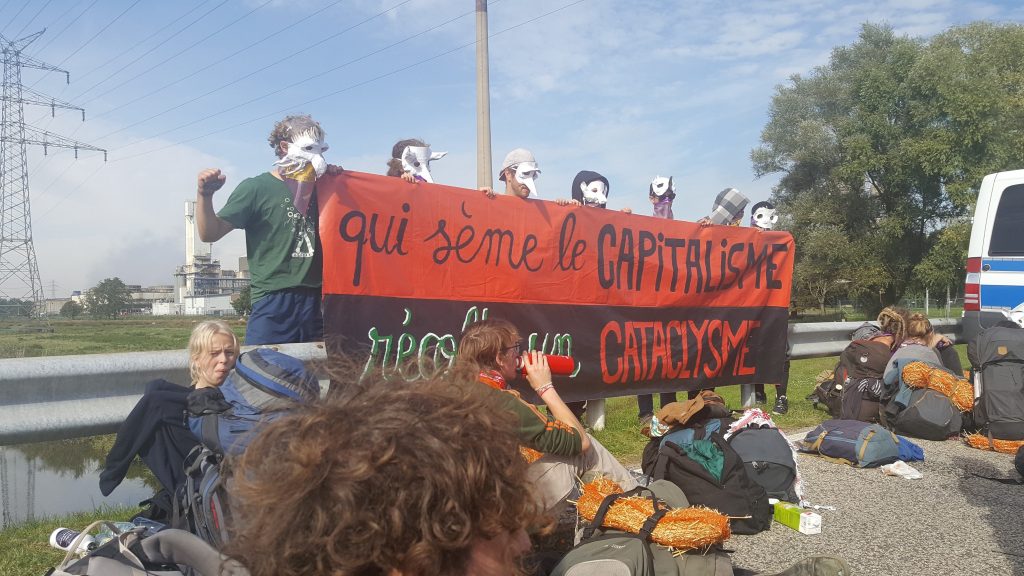
I wouldn’t quite share in the disappointment of the old school activist. Although the action was a failure on its own terms, not having stopped the production at the factory, it was a success in many other ways. It gave many people their first taste of mass direct action. It created a network of climate activists extending across north Europe. It brought attention to the destructive nature of industrial farming. Ultimately, when it became clear that the two blockages weren’t going to be enough to stop production, the central organisers weren’t prepared to undertake further, riskier, actions. This left it up for smaller groups to self organise. But this on the fly organisation had the problem of police infiltration. Because the action was completely open, there were spies in the camp, ultimately leading to the failure of both actions. The yellow finger failed because the police knew what was coming, and could adequately prepare. The activists who broke into the compound did manage to keep their action a secret, but, because of this, the group was a small one, and the police could contain it. If, while the police busy was this group, three or four other groups managed to break in, the ensuing chaos would have likely forced Yara to shut production. But this is speculation. What is important is that we learn from what went wrong, what went right, and continue the struggle.
For more information: https://freethesoil.org/